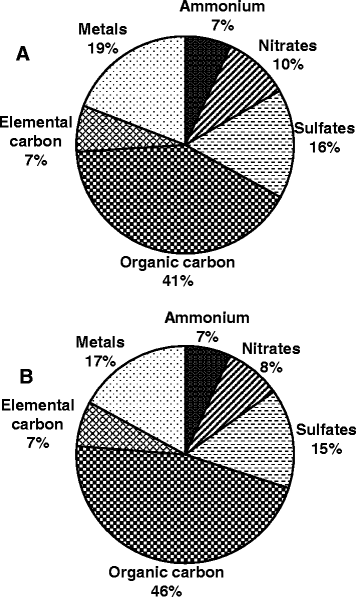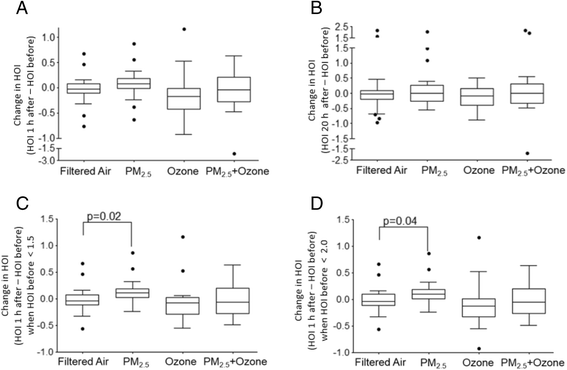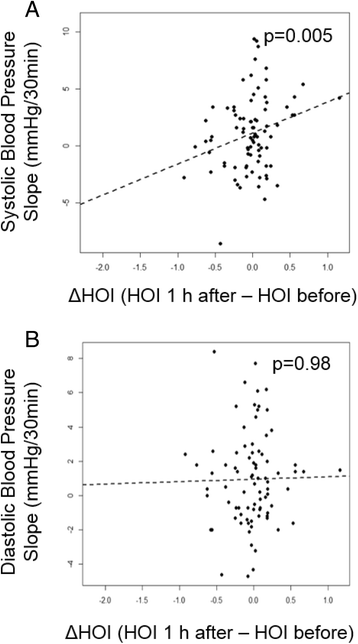Effects of urban fine particulate matter and ozone on HDL functionality
- PMID: 27221567
- PMCID: PMC4879751
- DOI: 10.1186/s12989-016-0139-3
Effects of urban fine particulate matter and ozone on HDL functionality
Abstract
Background: Exposures to ambient particulate matter (PM) are associated with increased morbidity and mortality. PM2.5 (<2.5 μm) and ozone exposures have been shown to associate with carotid intima media thickness in humans. Animal studies support a causal relationship between air pollution and atherosclerosis and identified adverse PM effects on HDL functionality. We aimed to determine whether brief exposures to PM2.5 and/or ozone could induce effects on HDL anti-oxidant and anti-inflammatory capacity in humans.
Methods: Subjects were exposed to fine concentrated ambient fine particles (CAP) with PM2.5 targeted at 150 μg/m(3), ozone targeted at 240 μg/m(3) (120 ppb), PM2.5 plus ozone targeted at similar concentrations, and filtered air (FA) for 2 h, on 4 different occasions, at least two weeks apart, in a randomized, crossover study. Blood was obtained before exposures (baseline), 1 h after and 20 h after exposures. Plasma HDL anti-oxidant/anti-inflammatory capacity and paraoxonase activity were determined. HDL anti-oxidant/anti-inflammatory capacity was assessed by a cell-free fluorescent assay and expressed in units of a HDL oxidant index (HOI). Changes in HOI (ΔHOI) were calculated as the difference in HOI from baseline to 1 h after or 20 h after exposures.
Results: There was a trend towards bigger ΔHOI between PM2.5 and FA 1 h after exposures (p = 0.18) but not 20 h after. This trend became significant (p <0.05) when baseline HOI was lower (<1.5 or <2.0), indicating decreased HDL anti-oxidant/anti-inflammatory capacity shortly after the exposures. There were no significant effects of ozone alone or in combination with PM2.5 on the change in HOI at both time points. The change in HOI due to PM2.5 showed a positive trend with particle mass concentration (p = 0.078) and significantly associated with the slope of systolic blood pressure during exposures (p = 0.005).
Conclusions: Brief exposures to concentrated PM2.5 elicited swift effects on HDL anti-oxidant/anti-inflammatory functionality, which could indicate a potential mechanism for how particulate air pollution induces harmful cardiovascular effects.
Keywords: Air pollution; Cardiovascular; Fine particulate matter; HDL function; HDL oxidant index (HOI); High density lipoprotein (HDL); Ozone.
Figures




Similar articles
-
No effect of acute exposure to coarse particulate matter air pollution in a rural location on high-density lipoprotein function.Inhal Toxicol. 2014 Jan;26(1):23-9. doi: 10.3109/08958378.2013.850761. Inhal Toxicol. 2014. PMID: 24417404 Free PMC article. Clinical Trial.
-
Effects of concentrated ambient particles on normal and hypersecretory airways in rats.Res Rep Health Eff Inst. 2004 Aug;(120):1-68; discussion 69-79. Res Rep Health Eff Inst. 2004. PMID: 15543855
-
Ozone co-exposure modifies cardiac responses to fine and ultrafine ambient particulate matter in mice: concordance of electrocardiogram and mechanical responses.Part Fibre Toxicol. 2014 Oct 16;11:54. doi: 10.1186/s12989-014-0054-4. Part Fibre Toxicol. 2014. PMID: 25318591 Free PMC article.
-
Effects of particulate matter on atherosclerosis: a link via high-density lipoprotein (HDL) functionality?Part Fibre Toxicol. 2020 Aug 4;17(1):36. doi: 10.1186/s12989-020-00367-x. Part Fibre Toxicol. 2020. PMID: 32753036 Free PMC article. Review.
-
Assessing Adverse Health Effects of Long-Term Exposure to Low Levels of Ambient Air Pollution: Implementation of Causal Inference Methods.Res Rep Health Eff Inst. 2022 Jan;2022(211):1-56. Res Rep Health Eff Inst. 2022. PMID: 36193708 Free PMC article. Review.
Cited by
-
Global research trends in atherosclerosis: A bibliometric and visualized study.Front Cardiovasc Med. 2022 Aug 23;9:956482. doi: 10.3389/fcvm.2022.956482. eCollection 2022. Front Cardiovasc Med. 2022. PMID: 36082127 Free PMC article.
-
Effects of ambient particulate matter on vascular tissue: a review.J Toxicol Environ Health B Crit Rev. 2020 Oct 2;23(7):319-350. doi: 10.1080/10937404.2020.1822971. Epub 2020 Sep 24. J Toxicol Environ Health B Crit Rev. 2020. PMID: 32972334 Free PMC article. Review.
-
Oxidative stress and the cardiovascular effects of air pollution.Free Radic Biol Med. 2020 May 1;151:69-87. doi: 10.1016/j.freeradbiomed.2020.01.004. Epub 2020 Jan 7. Free Radic Biol Med. 2020. PMID: 31923583 Free PMC article. Review.
-
Where There Is Smoke, There Is Fire.Arterioscler Thromb Vasc Biol. 2019 Mar;39(3):306-308. doi: 10.1161/ATVBAHA.119.312398. Arterioscler Thromb Vasc Biol. 2019. PMID: 30811249 Free PMC article. No abstract available.
-
Cardiovascular adaptations to particle inhalation exposure: molecular mechanisms of the toxicology.Am J Physiol Heart Circ Physiol. 2020 Aug 1;319(2):H282-H305. doi: 10.1152/ajpheart.00026.2020. Epub 2020 Jun 19. Am J Physiol Heart Circ Physiol. 2020. PMID: 32559138 Free PMC article. Review.
References
-
- Brook RD, Rajagopalan S, Pope CA, 3rd, Brook JR, Bhatnagar A, Diez-Roux AV, Holguin F, Hong Y, Luepker RV, Mittleman MA, et al. Particulate matter air pollution and cardiovascular disease: An update to the scientific statement from the American Heart Association. Circulation. 2010;121:2331–2378. doi: 10.1161/CIR.0b013e3181dbece1. - DOI - PubMed
-
- Pope CA, 3rd, Burnett RT, Thurston GD, Thun MJ, Calle EE, Krewski D, Godleski JJ. Cardiovascular mortality and long-term exposure to particulate air pollution: epidemiological evidence of general pathophysiological pathways of disease. Circulation. 2004;109:71–77. doi: 10.1161/01.CIR.0000108927.80044.7F. - DOI - PubMed
-
- Diez Roux AV, Auchincloss AH, Franklin TG, Raghunathan T, Barr RG, Kaufman J, Astor B, Keeler J. Long-term exposure to ambient particulate matter and prevalence of subclinical atherosclerosis in the Multi-Ethnic Study of Atherosclerosis. Am J Epidemiol. 2008;167:667–675. doi: 10.1093/aje/kwm359. - DOI - PubMed
Publication types
MeSH terms
Substances
Grants and funding
LinkOut - more resources
Full Text Sources
Other Literature Sources
Medical
Miscellaneous

